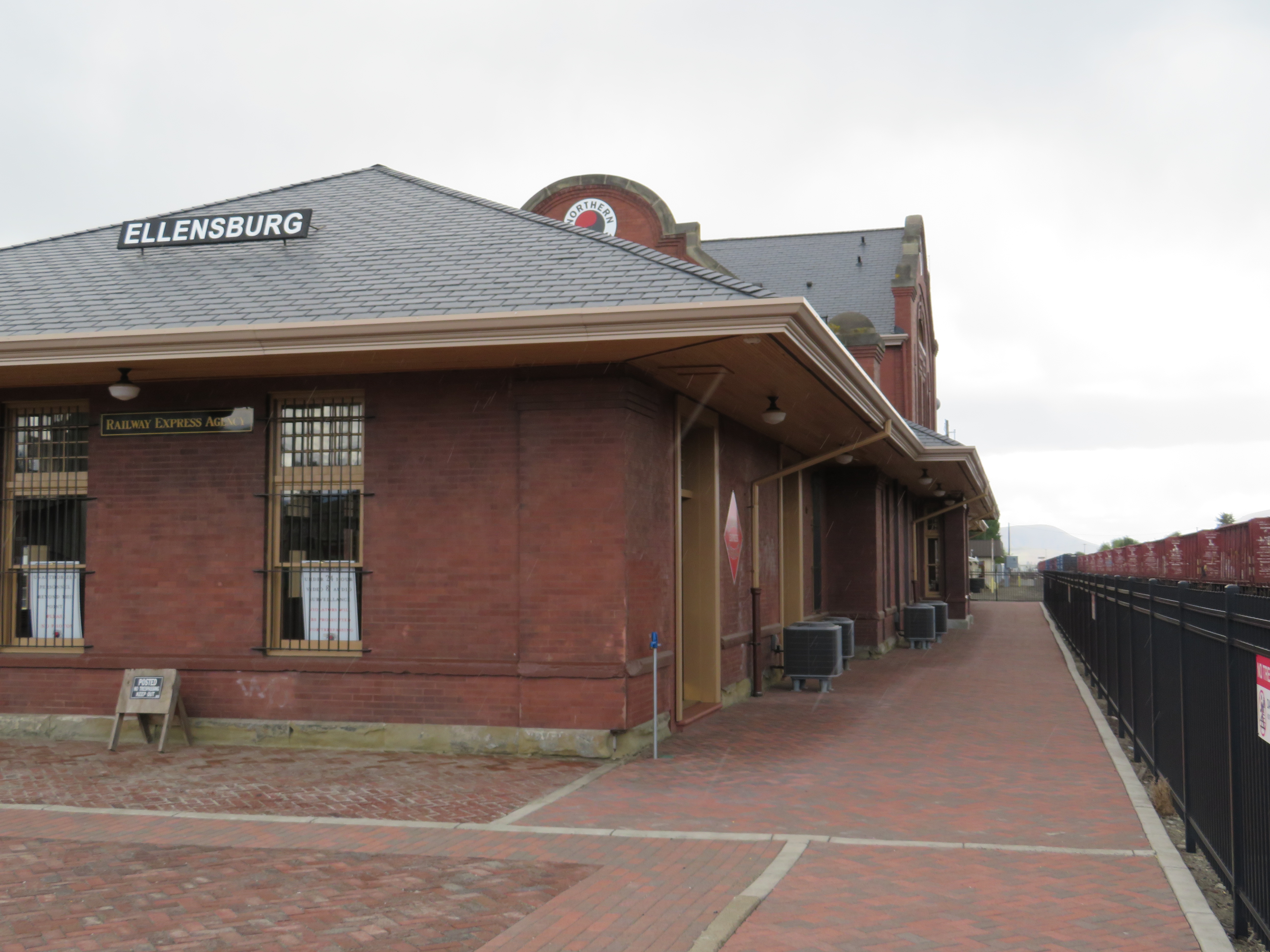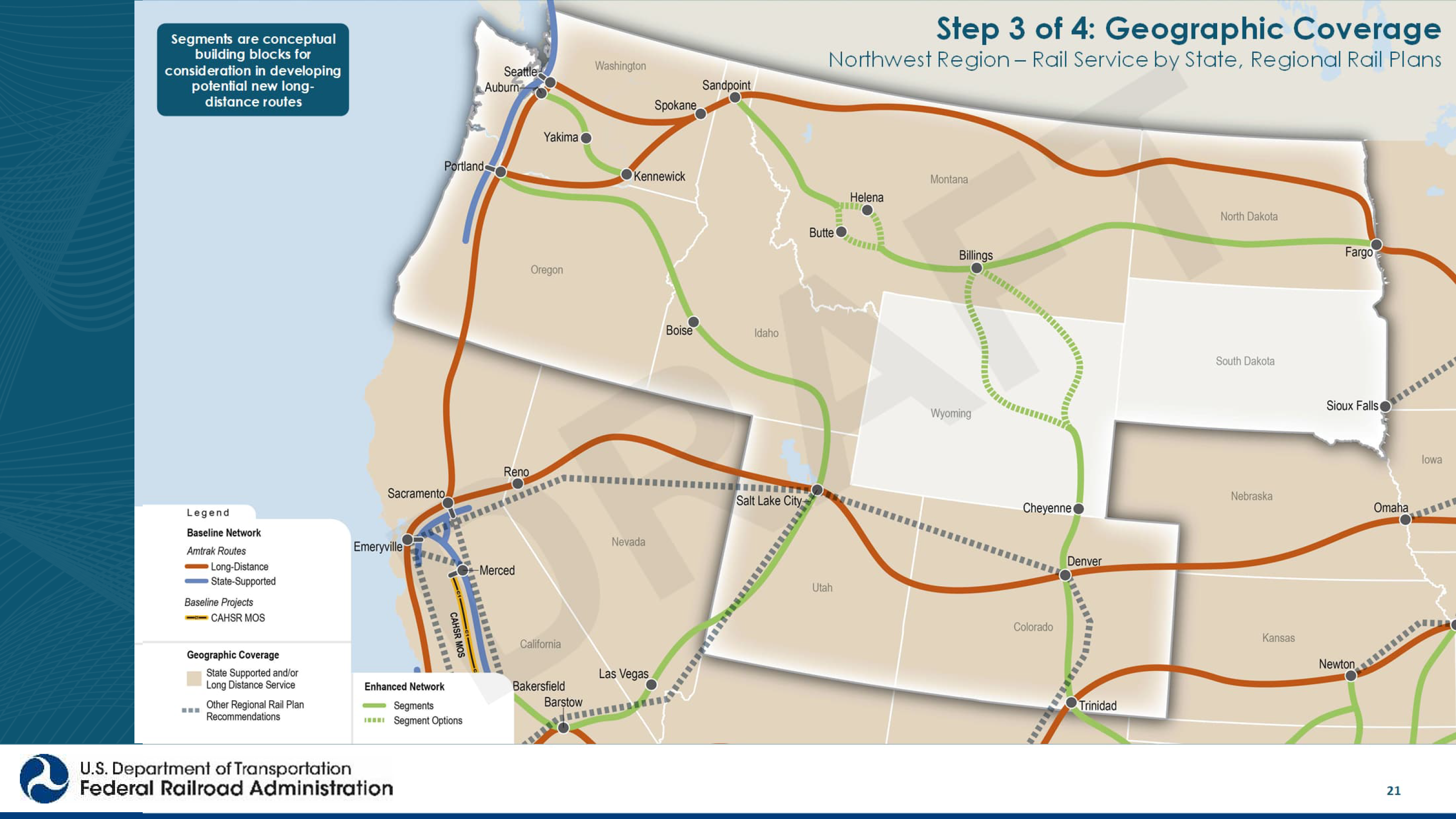East-West
East-West Passenger Rail Service

A map of the proposed passenger rail service along the Stampede Pass line, recently studied by the Washington State Joint Transporation Committee.
East-West Passenger Rail: Giving Central and Eastern Washingtonians Their Fair Share
All Aboard Washington supports the restoration of daytime passenger train service between Seattle and Spokane via Stampede Pass. East-West trains serving the Yakima and Kittitas Valleys would improve public transportation access, safety, and convenience for residents and visitors alike.
Stampede Pass Service–One Step Closer?
In July 2023, the regional working groups providing the Federal Railroad Administration with feedback on the FRA Amtrak Daily Long-Distance Service Study have published a map of a “Conceptual Enhanced Network” that would include restored service to several routes in the Northwest, including the former North Coast Hiawatha and Pioneer Amtrak routes.
The North Coast Hiawatha and North Coast Limited traveled several routes over the years, including some stations currently served by the Seattle leg of the Empire Builder. In order to serve the most population, tribal nations, and geographic diversity, a restored NCH would likely serve some or all of these stations:
Seattle
King Street Station in Seattle was buit in 1906 and extensively renovated in 2013. It is owned by the City of Seattle. Trains from King Street Station include:
- Amtrak Cascades to Vancouver Canada, Portland Oregon, Eugene Oregon and intermediate stops
- Amtrak's Empire Builder to Spokane, St.Paul/Minneapolis and intermediate stops
- Amtrak's Coast Starlight to Portland, Sacramento, Los Angeles and intermediate stops
- Sound Transit's Sounder regional rail service to Everett and Lakewood
Auburn
Sound Transit's Auburn station opened in 2000. It is served by Sound Transit's S Line trains between Seattle and Lakewood.
Cle Elum
There is room in the BNSF rail yard for a new structure.
Ellensburg
The 1910 Ellensburg depot has been renovated. It is owned by the Friends of the Northern Pacific Train Depot, which is selling it to the community nonprofit HopeSource, but with ADA updates, it can be reopened for passenger service.
Yakima
The original Yakima depot, built in 1910 and owned by BNSF, is now a restaurant. Local officials are considering a new multi-modal station that would serve passenger rail, intercity buses and local transit, in a number of locations near and around Yakima.
Toppenish
The 1911 Toppenish depot's original waiting room has been restored and is a museum. It is one of four locations on Yakama Nation lands being considered.
Prosser
The Prosser depot is owned by Historic Downtown Prosser and is being renovated.
Pasco (Tri-Cities)
Pasco's intermodal station is served by the southern leg of Amtrak's Empire Builder between Portland, Spokane and Chicago, as well as intercity bus and local transit service. It was built in 1998 and is owned by the City of Pasco.
Connell
BNSF has some maintenance buildings here, but the original depot is no longer standing. There is room in the right-of-way for a new facility.
Ritzville
Ritzville's depot, built in 1910, has been renovated as a museum and as the centerpiece of an extensive downtown redevelopment. It is owned by the City of Ritzville.
Cheney
The Cheney depot has been moved from its original location and is being renovated. Also under consideration is a new facility in the parking area of the Cheney Visitor Center.
Spokane
Built in 1891 and renovated in 1994, the Spokane depot is the meeting point for Empire Builder trains to Seattle, Portland and Chicago. It is also served by Amtrak Thruway buses, intercity buses and local transit. It is owned by the City of Spokane.
Eastward from Spokane, the service would continue east through southern Montana, southern North Dakota, and on to Chicago. Once the needed infrastructure improvements are in place, additional frequencies could be added.
Frequently Asked Questions
Read our East-West FAQ.
How You Can Make It Happen
Here's what we need to do to help move East-West passenger rail service forward:
- Have your city or county sign a resolution of support. You can use this for your own city/county.
- Ask your state legislators to support an economic impact analysis of East-West passenger rail service.
- Ask your congresspeople to support the creation of a Northwest Rail Commission, like the Southern Rail Commission serving the Southeast US.
- Talk with your county officials about creating a new county rail district or applying for state matching funds from an existing one.
Existing East-West Service
- The Empire Builder: Trains 7 and 8, Seattle - Spokane via Stevens Pass
- The Empire Builder: Trains 27 and 28, Portland - Vancouver (WA) - Spokane via Columbia River route
Studies
- 2001, WSDOT
- 2017, Central Washington University
- 2020, Legislative Joint Transportation Committee/STEER
- 2020, AAWA Response
Potential Funding Sources
Public Support or Public/Private Partnership
The 2019-20 Feasibility Study identified three potential models for funding:
- Public Outsourcing
- Contracts operation to Amtrak
- Similar to State Supported services across the United States including the Cascades
- Assets including rolling stock, stations, etc. funded and owned by Washington
- Private Outsourcing
- Contracts to a third-party/private operator
- Alternative procurement approaches available including the possibility of a public-private partnership
- State Operated
- State establishes an internal company to design, deliver and operate (significant step-up)
- Sub-options where WSDOT has more control over certain activities (akin to California)
Regional Rail Commission
Federally-chartered regional rail commissions make it easier for multiple states to work together and become competitive applicants for federal rail project funding. With strong interest in intercity passenger rail services in Oregon and Idaho, Washington would stand to benefit from cooperating with these states in a Northwest Rail Commission. The first step to making this a reality is in creating enabling legislation for a regional rail commission at the state level. Once Washington has expressed its support for joining the Northwest Rail Commission, we can move forward with further steps to start working better together.
County Rail Districts
County Rail Districts (CRDs) allow counties not currently part of a port district to receive state matching funds from sales taxes. Read more about why we need CRDs and what you can do to make them a reality.
Local Support
Communities receive significant benefits from hosting passenger rail service. Many have matched other sources to market the service, and to build and maintain train stations in their communities.
Communities With Locally-Supported Train Stations
These communities serve as great examples of train stations that were funded and created with significant local support:
Central Washington Passenger Rail Summit
Recording from July 11, 2020, event
- Agenda
- Meeting Presentations from AAWA and Transportation for America
- Meeting Presentation from STEER
- Recording on TVW

